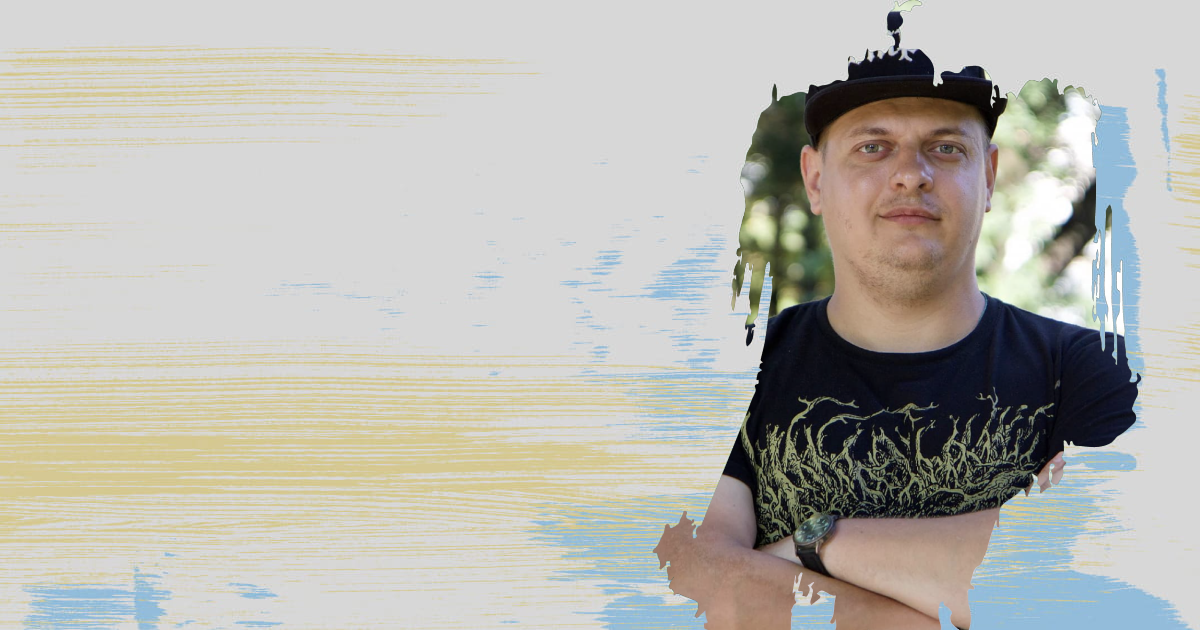Artists Against War: The Visual Language of War. An Interview with Andrii Dankovych

Svidomi in collaboration with Artists Against War, an online gallery of posters created to support Ukraine after the Russian full-scale invasion, tell the stories of the artists who help Ukraine by means of art. Read an interview with the artist Andrii Dankovych.
— What did you do before the beginning of the full-scale invasion?
— I am an artist and an illustrator. I was getting commissions to design book covers and book illustrations, T-shirt prints. I also drew and published my own comics.
— Can you describe your day of February 24?
— I was in Lviv. I woke up around 7 am. I got a million of notifications on my phone from friends, various chats and public pages: lots of obscure messages about some missiles, explosions. An air siren could be heard outside, but I didn't realize until later that it was an air raid alert. I was shocked, I couldn't believe that it was actually happening. Then I spent the whole day monitoring the news.
— Has your activity changed since the beginning of the full-scale invasion?
— My main activity has remained the same. I devote most of my time to work, but in addition to that, I also draw a lot as a volunteer.
I had a project with T-shirts: I drew various artillery pieces and military equipment for printing. We sold about 300 T-shirts in a month, and donated the collected funds to the Come Back Alive Foundation. Then again, I draw portraits of the military people: at first these were my friends only, but then the selection expanded.
There are many other war theme illustrations, for instance, drawings of the Ghost of Kyiv and the Neptune, a Ukrainian anti-ship cruise missile. Most of the images on my Instagram are on the war themes now, even though I wasn't interested in this before February 24.
I am also almost done with drawing the second part of my comic book, Mor (The Plague). During the first month of the full-scale invasion I didn’t even look in that direction, because I focused all my forces and resources on the war themes.
— How does the ninth month of the full-scale war affect your creativity?
— At the beginning of the invasion, my works were impulsive, and now they are more thought out. Sometimes it happens that certain events inspire me, for example, the counteroffensive in the Kharkiv region; then the idea comes spontaneously to my mind, I immediately bring it to life, and make it available to the public. Now, I have developed a certain system of working, so it has become easier to combine my creativity for different needs.
Besides, I try to filter the information more and limit the sources from which I get it; otherwise, it has a destructive effect on my creativity: when some news triggers me a lot, I fall into a stupor. Therefore, I consume less information, I make an adjustment for the fact that we are living in a state of war, we must wait for the official information, and distinguish between political and military sources. As a result, my productivity increased, and I procrastinate less. According to my own feelings, in the first months of the invasion I was only 10-20% productive as compared to what I could do before.
— What response to your creative works do you observe? Was there any feedback from abroad?
— You never know how people will react and respond to certain drawings. One work may become an instant hit, while another will not, but in the process of creativity I try not to think about it.
I felt tremendous support from abroad: from the USA to Zimbabwe. Even in the first days of the full-scale war, a lot of people wrote to me: both friends and people with whom I worked a year ago or even more, as well as those with whom I just started cooperating. Even strangers offered me to come to their place, or were just wondering how I was.
— How does art help in a war? What is its role?
— Like, perhaps, many of us, I stumbled at the thought that my activity is unimportant and insignificant as compared to what the military people or volunteers do. But when the servicemen and servicewomen themselves write that my works are inspiring to them, I understand that I am doing all this not in vain.
In addition, it is propaganda in a good sense — nowadays you can’t get away without it. In the Ukrainian Insurgent Army (UPA) there was an artist, Nil Khasevych, and thanks to his visual images we remember the UPA now.
It is by way of evolution that people remember pictures first, so art plays a very important role in a war.


